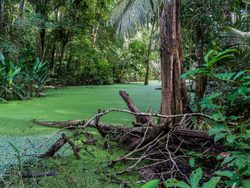
Madidi National Park
Quick Navigation
Madidi National Park is located in the northeastern part of Bolivia along the upper Amazon river basin. The national park encompasses an area of 7,319.7 square miles (18,958 sq km).
Although not contiguous, Madidi National Park combines with neighboring Apolobamba, Manurip-Heath, and the Peruvian Manu Biosphere Reserve to create one of the largest protected areas in the world. The elevation in the park varies from 1,968 to 19,685 feet (200 to 6,000 m) above sea level.
The Bolivian montane dry forests, Bolivian Yungas, the Tuichi River and the surrounding rainforest combined with the glacier-covered peaks of the Andes Mountains work together to create one of the most biologically diverse ecoregions in the world. Steep slopes, meandering rivers and streams, dense lush jungles, cloud forests, and snow-capped mountains await those who venture into this remote world of the Amazon.
The diverse ecoregions mean that Madidi National Park is home to more than 20,000 species of plant life and an array of wildlife species.
Wildlife is comprised of 272 species of mammals, 213 species of amphibians, 204 species of reptiles, 496 species of fish, and 1,254 species of birds. Not to be outdone, the insects contribute over 120,000 species. Jaguar and cougar are some of the most hopeful predator sightings. Other intriguing wildlife includes tapir, capybara, red deer, manatee, giant river otters, and pink river dolphins. The macaw is one of the most beautiful of birds that might be seen.
Highlights
The highlight of Madidi National Park is the diversified biodiverse ecoregions with the accompanied abundance and array of flora and fauna species. For the more adventurous traveler who wants to explore the Amazon region and experience a wide range of wildlife, Madidi is a targeted destination.
Amazon Rainforest
 The Amazon Rainforest is renowned around the world as the most diverse and biologically varied ecosystem in the world. Madidi National Park only reflects a small portion of the 2,700,000 square miles (7,000,000 sq km) of the larger Amazon Rainforest. Almost 60% of the rainforest is housed in Brazil and accounts for 40% of the country's landmass.
The Amazon Rainforest is renowned around the world as the most diverse and biologically varied ecosystem in the world. Madidi National Park only reflects a small portion of the 2,700,000 square miles (7,000,000 sq km) of the larger Amazon Rainforest. Almost 60% of the rainforest is housed in Brazil and accounts for 40% of the country's landmass.
The Amazon Rainforest may be mostly in Brazil, however, it extends into nine different countries. Peru is the second-largest representation of the rainforest but only accounts for 13% with only minor amounts in Bolivia. It s a South American shared natural wonder, and although the majority of it is in Brazil, Bolivia delivers through Madidi National Park providing travelers with one of the best chances to explore the Amazon Rainforest.
The Amazon Rainforest is estimated to have 390 billion individual trees accounted for by 16,000 different species. The ecological success and sustainability of the rainforest are grounded in the persistently hot temperatures combined with significant rainfall and high levels of humidity creating the perfect equation for abundant prolific vegetation.
Madidi National Park Trails
The Chalalan area features over 11.6 miles (30 km) of trails specifically for exploring the diversity with accompanied interpretation. You may explore things on your own, or you may engage one of the local guides who will both increase the understanding of the area while also providing a great sense of security.
It is even possible to engage one of the offered evening hikes that provide the more adventurous hiker with a chance to experience the nocturnal wildlife of the park.
Madidi Highlights
- One of the most ecologically diverse places in the world
Park Map
Sources
- Bolivia Hop, Madidi National Park, https://www.boliviahop.com/madidi-national-park/, retrieved September 2019.
- Bolivian Life, Guide to Madidi National Park, https://www.bolivianlife.com/madidi-national-park/, retrieved September 2019.
- Britannica, Amazon Rainforest, https://www.britannica.com/place/Amazon-Rainforest, retrieved June 2020.
- Cultural Trip, 10 Things to Know Before Visiting Madidi National Park, https://theculturetrip.com/south-america/bolivia/articles/10-things-to-know-before-visiting-madidi-national-park-bolivia/, retrieved September 2019.
- Linking Tourism & Conservation, Madidi National Park, https://www.ltandc.org/madidi-national-park-bolivia-examples-from-chalalan-ecolodge-and-san-miguel-del-bala-2/, retrieved September 2019.
- Lonely Planet, Expedition Travel Reveals Incredible Diversity In Bolivian National Park, https://www.lonelyplanet.com/articles/bolivia-expedition-diversity-national-park, retrieved September 2019.
- New York Times, Is This the World’s Most Diverse National Park?, https://www.nytimes.com/2018/05/22/science/bolivia-madidi-national-park.html, retrieved September 2019.






















